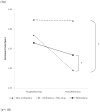Pregnancies exposed to methadone, methadone and other illicit substances, and poly-drugs without methadone: a comparison of fetal neurobehaviors and infant outcomes
- PMID: 22041255
- PMCID: PMC3288292
- DOI: 10.1016/j.drugalcdep.2011.10.003
Pregnancies exposed to methadone, methadone and other illicit substances, and poly-drugs without methadone: a comparison of fetal neurobehaviors and infant outcomes
Abstract
Background: It is suspected that there is a continuum of impairment among prenatally drug-exposed infants, such that opioid and/or poly-drug exposure confers the highest risk for adverse neonatal outcomes than other classes of substances or single substance exposures. Suitable control groups are difficult to identify. This study compared fetal neurobehavioral development and infant outcomes in offspring of three groups of pregnant women in drug treatment. Exposure groups include: Methadone+other illicit substances (MM+Poly) and two groups currently abstinent for poly drug exposures: Methadone only (MM/A) and Non-Methadone (NM/A).
Methods: Forty-nine women (19 MM+Poly, 18 MM/A, and 12 NM/A) underwent fetal monitoring at 36 weeks gestation at peak and trough levels of methadone (MM+Poly; MM/A) or at comparable morning and afternoon times (NM/A). Fetal heart rate (FHR), heart rate variability (FHRV) and motor activity (FM) data were collected. Infant measures included birth outcomes and Neonatal Abstinence Syndrome (NAS) assessment.
Results: As compared to the NM/A group, cardiac measures were decreased in methadone-exposed fetuses at peak levels. FHR was significantly more suppressed in the MM+Poly group. FM was significantly lower in the MM/A vs. the NM/A group at both peak and trough, indicative of more persistent exposure effects. The MM+Poly group delivered 1 week earlier and required NAS pharmacological treatment twice as often as the MM/A group.
Conclusions: Results support the notion that poly-drug exposure may potentiate the effects of methadone on the fetus and infant and highlights the need for intensified treatment for methadone-maintained women who abuse other substances.
Copyright © 2011 Elsevier Ireland Ltd. All rights reserved.
Conflict of interest statement
Figures



References
-
- Anyaegbunam A, Tran T, Jadali D, Randolph G, Mikhail M. Assessment of fetal well-being in methadone-maintained pregnancies: abnormal stress tests. Gynecol Obstet Invest. 1997;43:25–28. - PubMed
-
- Archie C, Lee M, Sokol R, Norman G. The effects of methadone treatment on the reactivity of the non-stress test. Obstet Gynecol. 1989;74:254–255. - PubMed
-
- Cejtin H, Mills A, Swift E. Effect of methadone on the biophysical profile. J Reprod Med. 1996;41:819–822. - PubMed
-
- Chasnoff IJ, Hatcher R, Burns WJ. Polydrug- and methadone-addicted newborns: a continuum of impairment? Pediatrics. 1982;70:210–213. - PubMed
-
- Cotes CD, Smith I, Fernhoff PM, Fatek A. Neonatal neuroalcoholism: clinical experimental research. Behavioral characteristics as correlates of maternal alcohol use during gestation. Alcohol Clin Exp Res. 1985;9:454. - PubMed
Publication types
MeSH terms
Substances
Grants and funding
LinkOut - more resources
Full Text Sources
Medical
Research Materials

